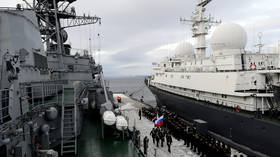Creating conditions for a very frozen conflict? US Navy to step up patrols in frigid Arctic waters off Russia’s northern borders

As Arctic ice retreats further each year, it helps to open up another front in the perennial standoff between Russia and the US, with both nations racing to dominate the space and control the emerging maritime trade route.
In a call with reporters on Tuesday, US Secretary of the Navy Kenneth Braithwaite announced that American sailors would increasingly set course for the frigid waters of the far North. “You will see the Navy operating again in a more permanent manner above the Arctic Circle,” he said, adding that the US will “operate more assertively” to challenge Russia’s claims in the region.
Speaking to the New York-based Breaking Defense news outlet, Braithwaite left the prospect of warships sailing into territory claimed by Russia open. “It’s sort of the same situation in the South China Sea that when we look at freedom of navigation operations and the ability to operate in international waters, the United States claims the right to be able to do that.”
Also on rt.com Arctic military force & coastal security system created as Putin approves state policy for key regionAccording to Russia’s Rosatom agency, 2020 was a record year for Russian shipping through the Northern Sea Route, with 32 million tons of cargo transported between European waters and the Far East. Its nuclear icebreakers cleared the path for close to 500 vessels over that period. In 2018, Russian President Vladimir Putin set a target of 80 million tons of goods to flow through the route, which lies wholly within Russia’s exclusive economic zone, by 2024.
The US has previously expressed concern, however, over Moscow’s growing influence in the region. “Our Pentagon has a role to play here – part of that is a response to Russia’s military presence in the Arctic, which is growing,” Michael Murphy, a deputy assistant secretary at the US State Department, said last May. “[It’s] established a new Arctic command there; it’s created new Arctic brigades; it’s refurbished old infrastructure from the Cold War, ports and airfields; it’s built new infrastructure.”
Early on in 2020, Putin signed off on the development of a new military force and coastal defense network for the region. According to the documents outlining the project, its objective is to deter aggression in the waters and ensure it remains “a territory of peace, stable and mutually beneficial partnerships.”
Also on rt.com Are you invading, or just lost? Russian navy threatens to ram US warship ‘John McCain’ after it crosses border near VladivostokThe prospect of so-called freedom of navigation operations in the Arctic is likely to cause concern in Moscow. Similar US efforts to challenge Russia’s borders have led to naval confrontations which have threatened to spiral into full-scale conflict. In November, a Russian warship threatened to ram the USS John S. McCain after it was discovered two kilometers inside the country’s waters in the Far East. American commanders insisted that it was there to challenge Russian claims to the Peter the Great Bay, adding that “by conducting this operation, the United States demonstrated that these waters are not Russia’s territorial sea.”
Think your friends would be interested? Share this story!












